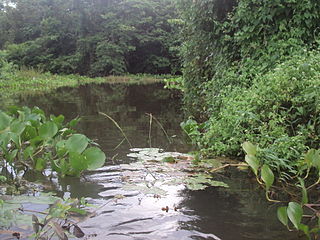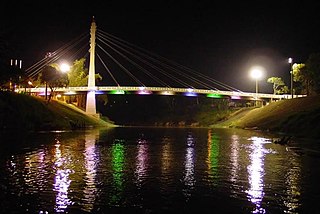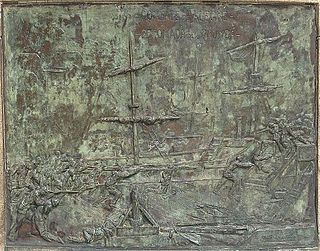
Brazilian cuisine is the set of cooking practices and traditions of Brazil, and is characterized by European, Amerindian, African, and Asian influences. It varies greatly by region, reflecting the country's mix of native and immigrant populations, and its continental size as well. This has created a national cuisine marked by the preservation of regional differences.

Mato Grosso is one of the states of Brazil, the third largest by area, located in the Central-West region. The state has 1.66% of the Brazilian population and is responsible for 1.9% of the Brazilian GDP.

Mato Grosso do Sul is one of Brazil's 27 federal units, located in the southern part of the Central-West Region, bordering five Brazilian states: Mato Grosso, Goiás and Minas Gerais (northeast), São Paulo (east) and Paraná (southeast); and two South American countries: Paraguay and Bolivia (west). It is divided into 79 municipalities and covers an area of 357,145.532 square kilometers, which is about the same size as Germany. With a population of 2,839,188 inhabitants in 2021, Mato Grosso do Sul is the 21st most populous state in Brazil.

An empanada is a type of baked or fried turnover consisting of pastry and filling, common in Spain, other Southern European countries, North African countries, Latin American countries, and the Philippines. The name comes from the Spanish empanar, and translates as 'breaded', that is, wrapped or coated in bread. They are made by folding dough over a filling, which may consist of meat, cheese, tomato, corn, or other ingredients, and then cooking the resulting turnover, either by baking or frying.

Campo Grande is a city in the central and western region of Brazil, capital of the state of Mato Grosso do Sul. Historically a stronghold of separatists from the North and South, founded by José Antônio Pereira. The city is planned in the middle of a vast green space, with wide streets and tree-lined avenues with several gardens along the way. It is one of the most wooded cities in Brazil, with 96.3% of houses in shade.

The Paraguay River is a major river in south-central South America, running through Brazil, Bolivia, Paraguay and Argentina. It flows about 2,695 kilometres (1,675 mi) from its headwaters in the Brazilian state of Mato Grosso to its confluence with the Paraná River north of Corrientes and Resistencia.

Corumbá is a municipality in the Brazilian state of Mato Grosso do Sul, 425 km northwest of Campo Grande, the state's capital. It has a population of approximately 112,000 inhabitants, and its economy is based mainly on agriculture, animal husbandry, mineral extraction, and tourism, being the gateway to the biggest wetlands of the world, the Pantanal. Due to its border with Bolivia, Bolivians in Brazil constitute a significant portion of the city's population, forming a distinct cultural community. The city is served by Corumbá International Airport.

BR-262 is an east-west highway connecting the Brazilian states of Espírito Santo, Minas Gerais, São Paulo and Mato Grosso do Sul.
Pastel is the Spanish and Portuguese word for pastry, a sugary food, and is the name given to different typical dishes of various countries where those languages are spoken. In Mexico, pastel typically means cake, as with Pastel de tres leches. However, in different Latin American countries pastel can refer to very different sugary dishes, and even to non-sugary ones as well. In some places, like Brazil, a pastel can refer to both a sugary and non-sugary food, depending on the filling used.

The Federal University of Mato Grosso do Sul, is a public university located in the state of Mato Grosso do Sul in Brazil. It has, in addition to the main campus in Campo Grande, nine campuses located in the following inland cities: Aquidauana, Chapadão do Sul, Corumbá, Coxim, Naviraí, Nova Andradina, Paranaíba, Ponta Porã and Três Lagoas.

Corumbá International Airport is the airport serving Corumbá, Brazil.

The Pantanal Matogrossense National Park is a national park in the state of Mato Grosso at the border to Mato Grosso do Sul, Brazil.

The Train of Pantanal is a railway in the state of Mato Grosso do Sul, Brazil that passes through the Pantanal region. It begins in the city of Campo Grande and ends in Corumbá, a total distance of 420 km. It is sometimes referred to, incorrectly, as the Train of Death. The 'Train of Death' was actually the continuation of the route across the border into Bolivia from Puerto Suarez to Santa Cruz del la Sierra, a true "Trem da Morte." In the absence of decent all-weather roads linking Corumba with Campo Grande, the train offered a decent journey, first and second class, a restaurant car and sleepers across the Pantanal to Bauru, taking over all about 30 hours. The completion of the road killed off the passenger railway service.

Pantanal Futebol Clube, commonly referred to as Pantanal, was a Brazilian football club based in Corumbá, Mato Grosso do Sul.
Bolivians in Brazil are individuals of full, partial, or predominantly Bolivian ancestry, or a Bolivian-born person residing in Brazil. The governments of Bolivia and Brazil have begun to develop an agreement to regularize the situation of several thousand undocumented Bolivian immigrants in Brazil. According to estimates by the Ministry's of Latin American immigrants and the National Association of Immigrants from Brazil more than 200,000 Bolivians are working illegally in São Paulo.

José Manuel Fontanillas Fragelli was a Brazilian politician, lawyer and academic. Fragelli served as the governor of Mato Grosso from 1970 until 1974 and the President of the Senate of Brazil from 1985 through 1987.

The Bolivia–Brazil border is the international border between the territories of Bolivia and Brazil. It extends from Corumbá, Mato Grosso do Sul, to Assis Brasil, in Acre.

The Our Lady of Candelaria Cathedral Also Corumbá Cathedral Is a church located in the center of Corumbá, state of Mato Grosso do Sul, in the South American country of Brazil. It is the place where the patron saint of the city is housed. A shield of the Portuguese crown is on its altar.

The Battle of Alegre was a naval battle of the Paraguayan War fought on July 11, 1867 near the city of Corumbá, on the São Lourenço River, present-day Mato Grosso do Sul, between Brazilians and Paraguayans. During the supply of meat, "carnage", for the troops that were there, coming from the resumption of Corumbá, a small squad of Paraguayan vapors had gone up the river in pursuit of the Brazilians, after the first ones had been defeated. The Paraguayan attack was of initial surprise, but they were defeated by the men of Lieutenant Colonel Antônio João da Costa. The loss and reconquest of the Brazilian steam Jauru stood out.


















